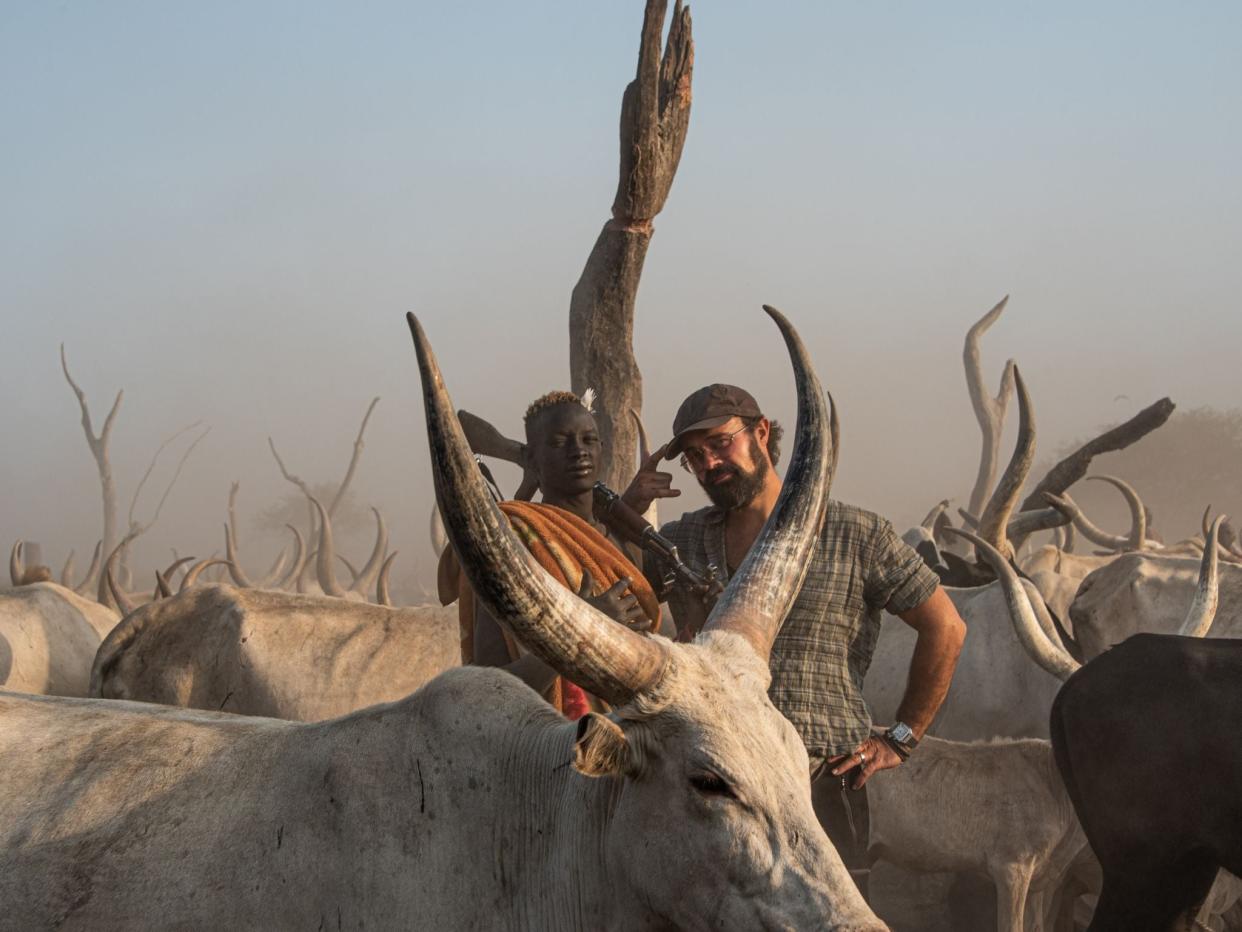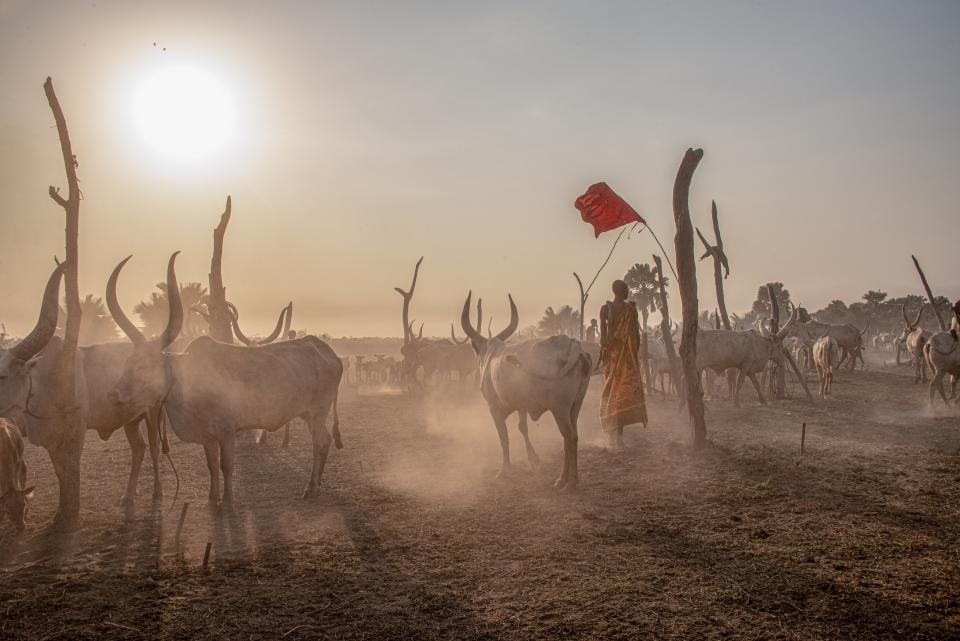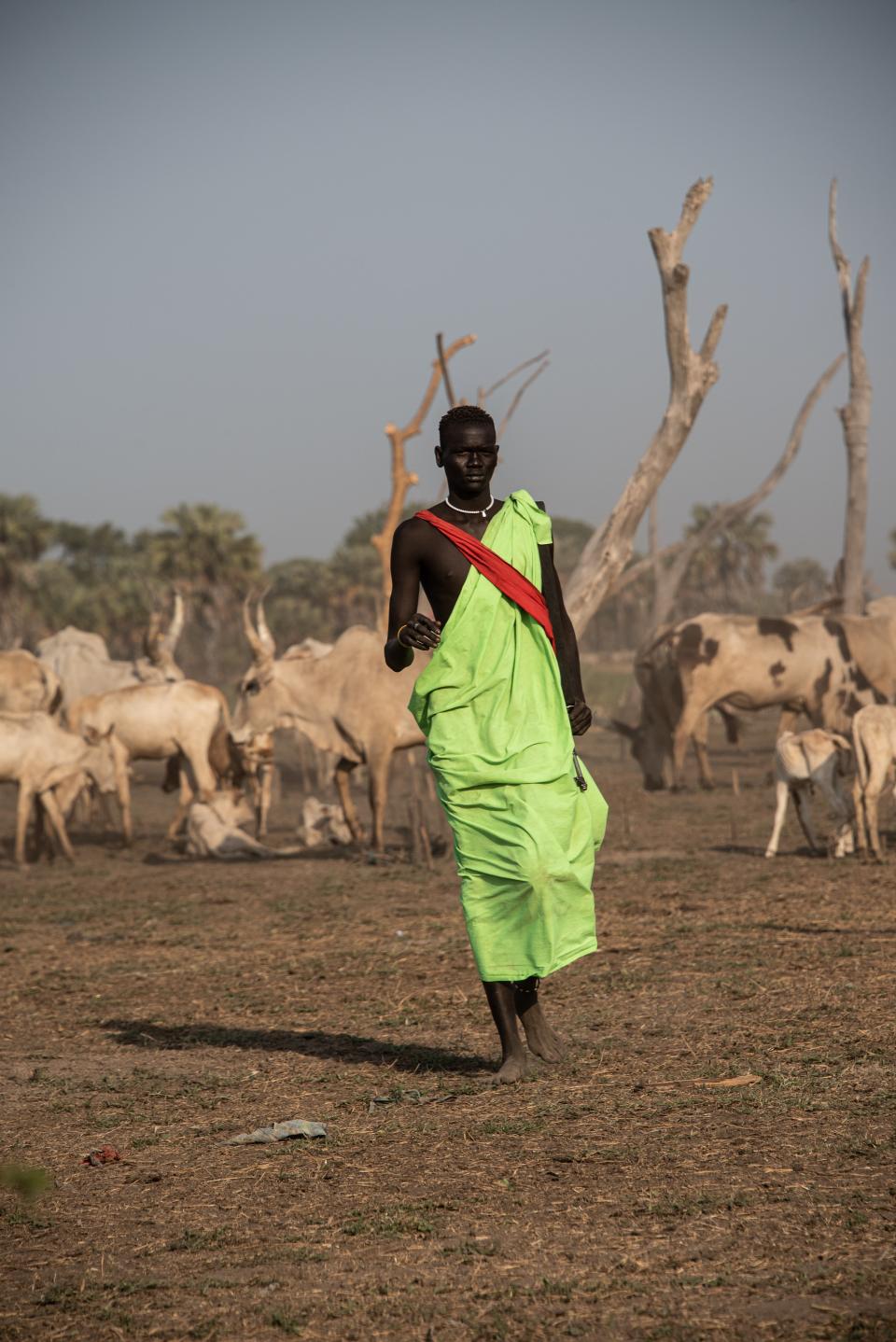Hope that one of world’s most endangered species lives on in South Sudan’s vast wilderness

Independent shareholder Evgeny Lebedev meets a herder at a cattle camp in South Sudan
(Valentina Morriconi)“The security situation remains volatile. Weapons are plentiful and easily obtained and criminals are often armed. The impact of the conflict, at both a national and local level, combined with a series of natural disasters (including flooding) drives a dire humanitarian situation across the country.” The Foreign Office advice for visiting South Sudan is hardly encouraging.
Only war-torn countries like Afghanistan, or indeed Iraq at the height of the Isis debacle, have seen stricter warnings to stay away and to get out fast. You can imagine my surprise upon arrival in the capital Juba to be met neither by the shells of burnt-out vehicles nor armed militia preying on foreigners.
That is not to say that there is no danger. The AK-47 is almost ubiquitous and there is not a village or town we visited where men did not have one rested over a shoulder. Those without Kalashnikovs often had a more traditional tool: the razor-sharp fighting bracelets made of metal or ivory that are placed around the limbs of young men while still adolescent so the arm grows around them, making the bracelets immovable when later used to slash or maim.
But, almost universally, the greeting I received was one of warmth, at times accompanied by the slaughter of a goat to celebrate our arrival. The main reaction elicited was not hostility. It was a far more perplexed question: “Why are you here?”
It was not an unfair question. Since its independence from (north) Sudan in 2011 after a civil war that lasted more than 20 years, the youngest country in the world has been continuously wreaked by conflict. The coalition that formed to win independence shattered and its component parts have struggled between themselves for power. This has not encouraged tourists, and even in the capital Juba our hotel complex on the Nile was surrounded by rows of walls and barbed wire.
Yet in the midst of this instability, and amid all the suffering and death that it has caused, there could be a little miracle in this land. It is a miracle that may mean a species, doomed to extinction, has a future. And that is why I was there: to see if amid the vast savannahs of South Sudan a future for the northern white rhino could be found.

The northern white rhino once grazed across central Africa. In the colonial era, it was hunted extensively by poachers and trophy hunters. But in the 1970s and 80s, political instability in its main habitats, not least the Congo, saw it almost wiped out. Traffickers targeted it to sell its ivory to consumers in Asia; many of whom believe it, with no medical evidence whatsoever, to be an off-brand Viagra. They might as well be grating nail clippings into their tea.
By 2008, there were just eight known northern whites left in two zoos on opposite sides of the world: in the Czech Republic and California. Attempts to get them to reproduce failed, even after two potential couples were moved to the Ol Pejeta Conservancy in Kenya in 2009 in the hope a more natural environment would stimulate breeding. Now just two remain, Najin and Fatu, who both are female and who live under 24-hour protection at Ol Pejeta. I met the last male, Sudan, before he died in 2018.
Scientists are desperately exploring the possibility of artificial reproduction technologies, using in vitro fertilisation and southern white rhino surrogates. But nothing has so far worked. At present, the northern white rhino faces certain extinction.
Yet there is one other hope for this species. And that hope lies in South Sudan.
Stop the Illegal Wildlife Trade
We are working with conservation charities Space for Giants and Freeland to protect wildlife at risk from poachers due to the conservation funding crisis caused by Covid-19. Help is desperately needed to support wildlife rangers, local communities and law enforcement personnel to prevent wildlife crime. Donate to help Stop the Illegal Wildlife Trade HERE
Rhinos have a long history in the country. Their image features on the Sudanese wildlife service’s crest. Tantalisingly, over the years there has been anecdotal evidence of a few northern whites surviving in the wilderness that still covers much of the country.
A helicopter crew claim to have seen two of them running across the savannah. Officials and tribal chiefs report sightings deep in the bush. Even the country’s vice-president has gone on record to claim he saw a mother and calf in the wild.
There has been no survey of South Sudan’s wildlife for over a decade and no comprehensive search has ever taken place for the northern white. With time running out for the species, I wanted to see if there was any real chance that there might be a future for it.

I visited three areas: the land around the towns of Rumbek, Yirol and Bor. In each of the towns the poverty was overwhelming. There is barely a paved road. Children could be seen working in markets or, in Bor, punting boats used on the tributaries of the Nile to ferry people and produce.
Outside of the towns, the people were largely nomadic, sleeping in clusters of domed huts made from the local flora that they would build and then abandon as they moved onto a new area. The main source of value is cattle, which is highly prized and the measure of a man’s wealth.

Those who could had more than one wife. Most of the young men spent months at a time at isolated cattle camps looking after the local families’ herds and fighting off raids from rival tribes who would steal not only their cattle but also, on occasion, the young women and the children also staying there.
Nevertheless, my team and I were able to visit the most promising havens of wildlife, and there I discovered much about the present state of conservation in the country. Firstly, there is little sign that many of the large expanses of national parks exist other than on paper. In Rumbek we visited the local wildlife service head. He told us that neither he nor his rangers had been paid in more than six months and were struggling to survive, let alone protect the nearby park.
At the Boma National Park near Bor, which at 22,000 square kilometres is one of the largest in Africa and dwarfs even South Africa’s Kruger National Park, cattle roamed freely over the area we saw and pastoralists were spotted lighting fire to clear the undergrowth. When we landed on the blackened earth, it was littered with giant empty snail-shells; the snails inside vaporised by the heat.
Secondly, there are few large mammals remaining. At watering holes we spotted old elephant tracks and droppings, but no live animals. The last national survey of wildlife in 2008 showed there were still some 20,000 elephants in the area. Now there are reports of groups remaining, not least hiding away on isolated islands between the tributaries of the Nile where they are safe from hunters, but the total is likely far fewer than before.

Yet that some of elephants survive is almost certain. The illegal ivory markets that operate by every town we visited, selling bangles for newlyweds and fighting bracelets, is testament to that.
We saw no buffaloes, although they could have retreated deep into the bush at the end of the dry season. Nor any big cats, although the antelope carcasses we occasionally saw hinted at the presence of leopards. During our entire visit we saw just four giraffes, although two were young calves – carrying with them some hope for the future.
But there are plenty of antelopes, as well as porcupines, hyena and other smaller mammals, all protected by the sheer remoteness of large areas of the country. South Sudan is larger than Britain and Germany combined, and with a population of fewer than 12 million, it is home to the biggest expanse of untouched savannah on the African continent. From the skies, there is barely a sign of permanent habitation for mile after mile of unchanging landscape.
Despite the country’s violent past and present instability, the durability of wildlife here is best illustrated by the annual kob migration.
Every year about a million white-eared kobs move west from their dry season habitat in Boma National Park to the plains near the Nile. Once in Bandingilo National Park, the tiangs join them in their tens of thousands as they undertake their migration southward from their dry season refuge in the swamps of the Sudd.

Scientists first started properly studying it at the latter end of the last century, when reports came in of at least one million antelopes, mostly white-eared kob and also tiang, gathering east of the Nile. The resulting migration is one of the greatest in Africa, behind only the wildebeest herds of the Serengeti.
For much of the 21st century it was unclear whether the migration was even taking place or if the war had led to its disruption, or even to the death of its herds. The warring groups were all relied on bushmeat to feed their troops, or took it in trucks to the cities to raise money for their cause. The fear was that the annual migration could become yet another victim of South Sudan’s conflict.
Yet it perseveres. I saw it for myself: the antelopes followed the same migration paths as centuries ago. It took us time to locate the main trail, but gradually, as we searched around Boma, we saw small groups of kobs running together. We followed them until the myriad groups coalesced and the plains were packed as far as the eye could see with countless antelopes doggedly making their way south.
It was a startling spectacle; a reminder of the power of nature to persevere despite the worst excesses man can impose upon it.

This brings us to our third discovery in South Sudan: which impacts on the future of the northern white rhino and also may hopefully serve as a fresh testimony to nature’s resilience against the odds.
Despite our efforts, we did not see a northern white, but we learnt enough to give hope that they may indeed endure. Speaking with the rangers, pilots and local chieftains, they gave detailed reports of sightings in specific areas. I shall not say exactly where, for fear that poachers find them before the conservationists do.
But the evidence indicates that they have adopted a nocturnal, less territorial pattern of behaviour to survive. One British conservationist had a photograph of a suspect footprint. Others talked of spotting them by water sources in the deepest and most inaccessible areas of the bush.
Yet what gave me hope above all that there may be credence to these sightings is the scale of the expanse that makes up most of the wilderness left in modern South Sudan. Some 12,000 square miles is largely untouched by organised human activity.
This is a country so large and so sparsely populated that for years the very question of whether a million antelopes continued to migrate remained an uncertain question. There is almost nowhere else on the planet that such a question could be posed.
The final answer to the mystery of if northern whites survive in South Sudan will involve the expansion of proper scientific study. Already there is a mapping team organised by British former UN adviser, Philip Winter. That will enable analysis by teams of researchers along transit lines and an on-the-ground search of identified blocks of potential rhino territory.
I am also in discussion with the Sudanese wildlife authorities about how to best assist its expertise. Last year, for the first time an indigenous conservation NGO was founded, the South Sudan Nature Conservancy Organisation, creating a potential partner for foreign conservationists.
I remember seeing the last known male northern white, Sudan, before his death. His home at Ol Pejeta was a fortress. In the midst of it he saw out his last days, craggy and often alone, surrounded by the walls and fences built to protect him.
On this trip I visited the spot in South Sudan close to where he was captured, aged three, and taken into captivity back in 1975. It was a place of utter tranquillity and beauty located by the vast depths of the Sudd.
The Sudd is a vegetation-dense swampland that spreads across the centre of South Sudan where the Nile feeds a network of lagoons and channels filled with papyrus fields and 12ft-high elephant grass. At the height of the rainy season it can extend for 130,000 square kilometres, an area the size of England.

It is only when you see such a landscape for yourself can you really understand the scale of the South Sudanese wilderness and the scale of the Sudd. Amongst this, the possibility of a few rhinos incarnating the last hope of the species is enticing.
Much of the Sudd is near impassable, either overland or by water. The collection of reeds, water hyacinth and grasses form massive blocks of vegetation, some stretching as far as 30km, which shift position and block channels as the network of water winds through the seasons.
It is a place so dense and so logistically challenging that for centuries the ancient Egyptians tried and failed to cross it. In AD61 emperor Nero sent a unit of Roman soldiers down the Nile to expand the empire. They too never got beyond the Sudd, its boundary marking the limit of Roman penetration into sub-Saharan Africa.
Today, what lives in the Sudd, and how, remains almost as unknown as it was to the Romans it vanquished two millennia ago. Its natural boundaries, and the instability in South Sudan that led to severe warnings to stay away like that of the Foreign Office, has created a unique environment for wildlife to survive outside the dangers of the modern world.
The fate of the northern white and its existence somewhere in the Sudd remains unknown, a mystery supported by stories and reports of sightings so tantalising that they verge on mythology. But this is a mystery with at its heart the question of a species’ survival. The search for an answer goes on.
Those wishing to book a tour, or a boat trip on the Nile, in South Sudan can go to geckotours.com.ss
Read More
Stop the Illegal Wildlife Trade: Cheetahs to return to Indian grasslands for first time in 70 years
Stop The Illegal Wildlife Trade: How your donations are now helping keep elephants safe in Kenya

